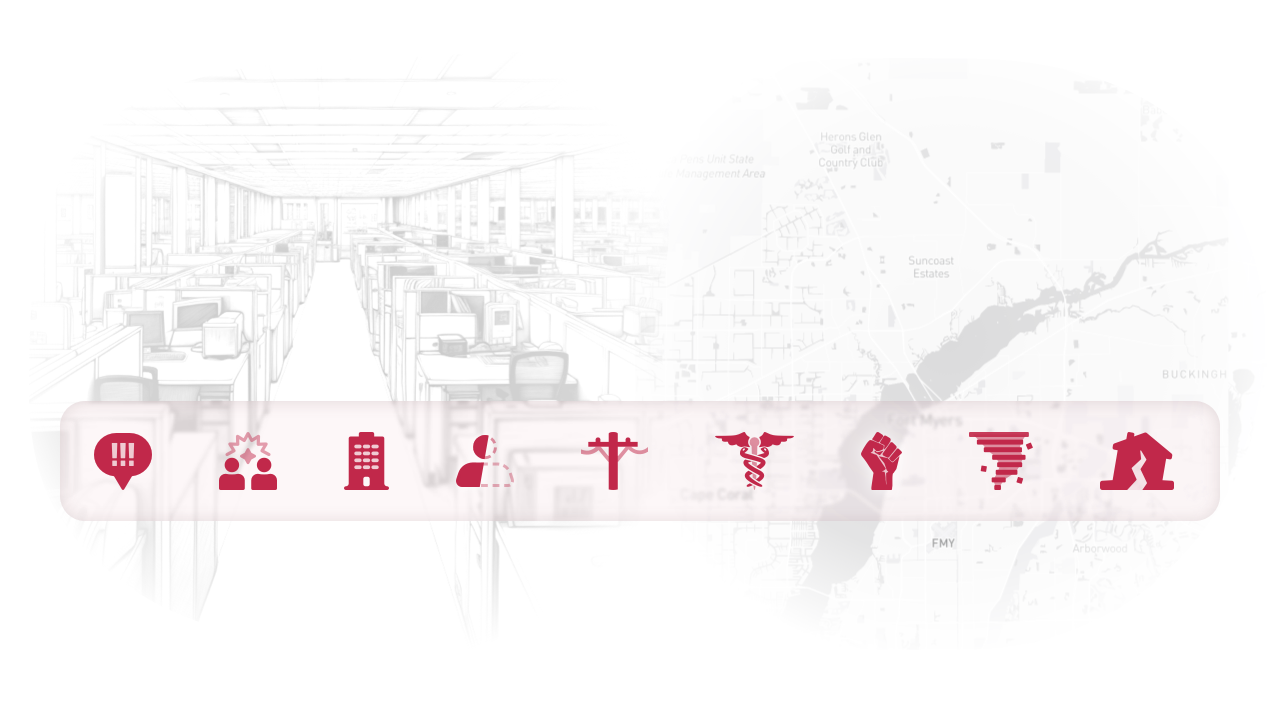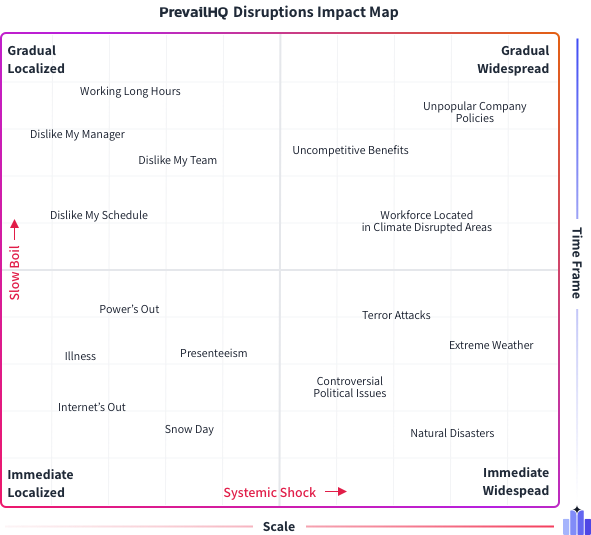
What types of disruptions threaten your workforce’s stability?
Workforce disruptions come in many forms and have diverse impacts on your business. They include everything from rising turnover, burnout, and absences to extreme weather, disasters, and other large-scale events.
What’s more, the specific disruptions you face are constantly changing.
They can vary from month to month, week to week, or day to day. These disruptions interact with each other to cause even more trouble for your business.
By implementing a system to manage disruptions, you can build a more stable workforce that delivers consistent results. Let’s explore how different types of disruption affect your workforce—and why you need a holistic solution that tackles all of them.
Sources of disruption: internal or external
What’s the best way to categorize workforce disruptions? First, consider the source.
Some disruptions come from outside your organization, while many others originate inside your workforce itself. To prevent staffing gaps and turmoil, you need solutions and strategies that address both types of disruption.
Internal disruptions
Internal disruptions occur because of conditions inside your workforce. They include:
-
Increased employee turnover
-
Disengagement and burnout within teams
-
Frequent unplanned absences
-
Rising employee relations issues
To a large extent, internal disruptions arise when your work environment fails to align with core employee expectations.
When your people feel frustrated with their workloads, relationships, communication, or schedules, it leads to behaviors that erode your workforce’s stability—such as sudden quitting or absenteeism.
External disruptions
External disruptions arise from the world outside of your organization. For example:
-
Extreme weather events
-
Natural disasters
-
Large-scale infrastructure outages
-
Viral outbreaks
-
Terror attacks
Unlike internal disruptions, external disruptions are totally out of your control. You can’t prevent a storm, earthquake, or pandemic.
The most you can do is plan for such events and strive to mitigate their impact.
Why the difference matters
Both internal and external disruptions can have costly impacts on your business. However, each requires a very different process of monitoring and mitigation—one focused on your internal work climate, the other on your outside environment.
To keep your workforce stable, plan for both types of disruption. Make sure to consider the specific vulnerabilities that affect your organization.
For example, pay special attention to how your internal work climate affects mission-critical teams or roles. Identify which external disruptions are most likely or impactful given your geographic location, industry, and workforce model (on-site, hybrid, or remote).
Categorizing disruptions by impact
Disruptions of any kind, internal or external, can have a wide variety of effects on your workforce and your operations.
Some disruptions have an immediate impact, while others grow over time. By the same token, their impact varies in scale—ranging from small-scale, everyday issues to massive events that touch your entire organization.
By graphing impacts on both time and scale, you can sort all disruptions into four basic categories.

1. Immediate and localized
Some disruptions have an impact right away, but only on a small part of your organization—for example, specific facilities, teams, or even individuals.
For instance, a specific team could lose multiple employees to sudden turnover, or a temporary power outage could sideline your staff at one or two locations. Despite their small scale, such disruptions can lead to significant costs if they affect staff members in critical roles.
2. Gradual and localized
Other localized disruptions may take time to build up steam. However, they can also cause real headaches once they gain momentum. Because of its gradual nature, this kind of disruption may escape notice until it’s too late.
Let’s say a specific unit suffers from excessive workloads and unpredictable schedules. The impacts may not be felt overnight—but if the underlying problems aren’t fixed, team members will eventually start to burn out or walk away.
3. Immediate and widespread
Immediate, widespread disruptions strike suddenly and have an impact across your organization.
Many of these are external events like weather or natural disasters. They could also include internal issues, such as fast-moving controversies that spark walkouts or mass resignations.
At their most destructive, such disruptions can make entire swathes of your workforce unavailable for hours, days, or even longer. As a result, you may experience significant losses of productivity and struggle to maintain normal operations.
4. Gradual and widespread
These are medium- to long-term issues with impacts that reach across your workforce. They could include company-wide challenges with engagement and retention, or growing disruptions from environmental risks.
Such disruptions don’t undercut your organization’s stability all at once. Instead, they erode performance and productivity over time. Their full impact may take time to materialize—but they can just be as costly as more dramatic, sudden disruptions.
Taking a unified view of workforce disruptions
To foster a stable workforce, don’t address problems in isolation. Instead, strive for a unified approach that helps you monitor, assess, and mitigate all types of workforce disruption.
Why is this so important?
-
Internal and external disruptions amplify each other. If either kind of problem destabilizes your workforce, the other could deliver a crushing blow. For example, a workforce suffering from rising turnover may be less resistant to external shocks.
-
The longer disruptions last, the more they tend to snowball. A localized disruption can escalate or become more widespread over time. If you wait too long to address problems, they may end up costing more than you expected.
-
Disruptions are constantly changing and interacting in new ways. You never know what combination of disruptions you’ll face next. Some disruptions may be easy enough to manage on their own—but you could have a mess on your hands when they pile up without warning.
When you try to address different types of disruptions separately, your response is often slow, inefficient, and incomplete. That not only allows trouble to escalate, but also puts stress on the managers and HR staff who are struggling to keep your workforce on track.
A holistic solution for workforce stability
For a more unified approach, you don’t just need the right strategy and planning. You need a technical solution that addresses all types of workforce disruption.
Such a solution provides the right data, insights, and tools to:
-
Solve problems with your internal work climate.
-
Detect and manage external disruptions.
-
Keep limited, small-scale disruptions from snowballing.
-
Prevent different types of disruptions from magnifying each other.
By adopting a holistic, centralized solution, you can anticipate and solve potential disruptions across the board.
Your managers, HR team, and executive leaders can work with a common source of data and insights, speeding up decisions and ensuring everyone is on the same page. And most important, you can build the stable, productive workforce you need.